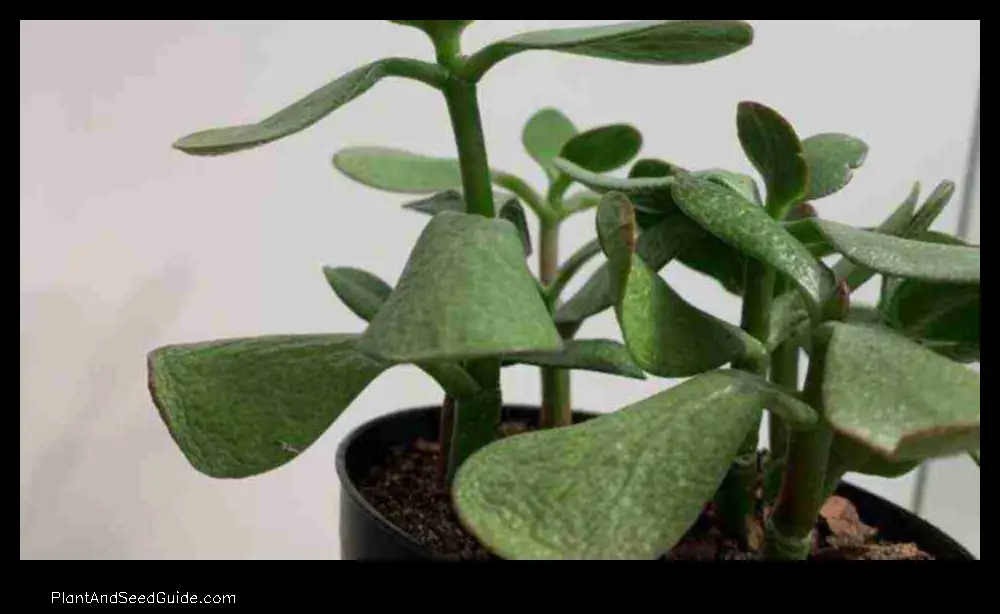When you purchase through links on our site, we may earn an affiliate commission. Here’s how it works.
Healthy jade plants have thick stems and fleshy leaves. If you notice your jade plant looks wrinkled, it’s the plant’s way of telling you something isn’t quite right. The good news is that often, wrinkled jade plants can be rejuvenated by altering the way you care for your plant. Most importantly, don’t assume you can water your jade plant the same way you water other indoor plants. Jades have quite different growing requirements. Here are a few tips for fixing a wrinkly jade plant.
Jade plants also known as money plants or lucky plants are popular and easy to care for succulents. Their thick, rounded green leaves and sturdy stems make them excellent houseplants. However, jade plant leaves sometimes turn yellow and wrinkled, which can be alarming for plant parents.
There are a few common causes for yellow, wrinkled jade plant leaves, but the problem is usually due to improper watering. With a few adjustments to your care routine, your jade plant’s leaves can return to their healthy green color and plump appearance.
Why Jade Plant Leaves Turn Yellow and Wrinkled
Jade plants store water in their thick leaves, which allows them to tolerate droughts in their native habitat When the leaves become thin and wrinkled, it’s a sign the plant is thirsty and needs more water Yellowing often accompanies a wrinkled appearance as the plant becomes increasingly stressed.
While under-watering is the most common reason for wrinkled, yellow leaves, overwatering can also cause similar symptoms. If the soil stays soggy, the roots may rot leading to yellow, wrinkly leaves.
Other factors like cold temperatures, pests, and old age can sometimes contribute to yellowing leaves as well. But in most cases, adjusting your watering routine is the solution.
How to Fix Yellow Wrinkled Leaves on Jade Plants
If your jade plant has wrinkled yellow leaves, take these steps to nurse it back to health:
1. Check for Underwatering
Feel the soil to determine if the plant is being under-watered. Stick your finger into the potting mix or use a skewer to test the moisture level. If the soil is bone dry, especially near the bottom, it needs more frequent watering.
2. Water Only When Dry
Jade plants should be allowed to dry out between waterings. Water thoroughly only when the top few inches of soil become dry. This may mean watering as infrequently as every 2-3 weeks in the winter when growth slows.
3. Improve Drainage
Repot in a container with drainage holes using a gritty potting mix made for cacti and succulents. These materials will prevent waterlogging that leads to yellow leaves.
4. Check for Overwatering
If you suspect overwatering, allow the plant to fully dry out for a week or so before watering again. Repot in dry soil if the roots are rotting. Cut off any mushy yellow leaves or stems.
5. Treat Pests
Inspect closely for signs of pests like mealybugs or scale insects, which can contribute to yellowing. Use insecticidal soap or neem oil to control any bugs present.
6. Move to Better Light
Low light can sometimes pale the leaves. If needed, move the jade plant to a spot with brighter (but indirect) sunlight. Rotate the plant periodically so all sides get sun exposure.
7. Raise Temperatures
Cold drafts and temperatures below 50°F (10°C) can shock jade plants. Move to a warmer spot and avoid placing near cold windows in winter.
With a little detective work and adjusting your care routine, you can get those jade plant leaves back to their normal beautiful green. Just be sure to pay close attention to your watering habits, as that is most often the culprit behind wrinkled yellow leaves. With proper care, your jade plant can thrive for years as a low-maintenance houseplant.

Wrinkled Jade Leaves: Underwatering
In nature, jade plants store water in their leaves, which allows the plants to survive dry periods. The leaves of a well-hydrated jade are plump, while thin, wrinkled jade leaves are a good sign that the plant needs water.
Don’t go by appearance alone, however, and never water without feeling the potting mix first. Ideally, water only when the potting mix is dry nearly to the bottom of the container. If you’re not sure, stick a wooden skewer in the pot to test the moisture level.
JADE plant WATERING (overwatering VS underwatering) OVERWATERED jade plant | MOODY BLOOMS
FAQ
Why are my jade plant leaves turning yellow and wrinkled?
Overwatering often leads to yellow, droopy leaves and a mushy trunk. If the soil feels soggy or the pot’s heavier than a dry spell in the desert, you’re overdoing it. Cut back on the H2O and consider better drainage. Underwatering, on the other hand, makes leaves soft and wrinkly, like a prune left out in the sun.
Why are my jade plant leaves wrinkling?
The wrinkled leaves are generally due to dehydration. This can be because of thirst due to needing water, or can be because the roots are compromised from overwatering and are thus not taking on water causing thirst.
What does an overwatered jade plant look like?
An overwatered jade plant will display several noticeable signs, including mushy, soft, or yellowing leaves, leaf drop, and potential root rot.
How do you rejuvenate a jade plant?
Wrinkled or dropping leaves mean that your jade plant needs extra hydration. To fix this, Hancock recommends watering your plant more regularly—or giving it a light trim. However, if it’s completely dried out, your jade plant could benefit from a good soak.
